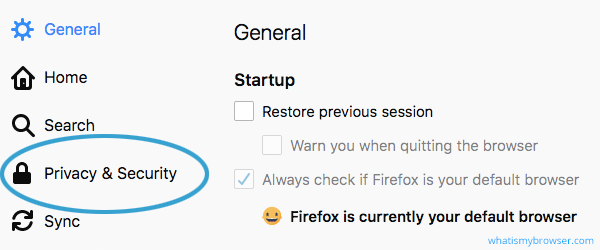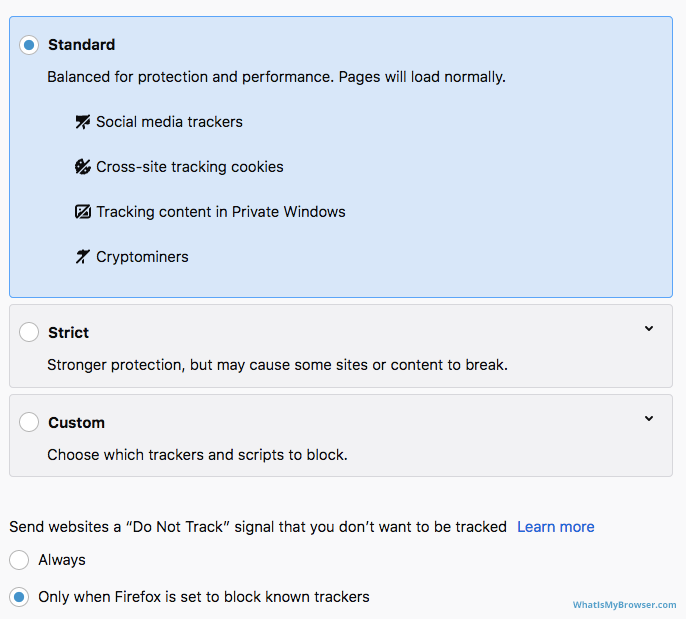Enable Cookies in Firefox
Updated at: Feb 19, 2022
This guide will step you through the process of enabling Cookies in Firefox.
If you don't have Firefox and would like to try it out, you can download it from the Firefox Website.
-
On your computer, click the menu button
The menu button will be in the top right-hand corner of Firefox; it looks like three horizontal lines on top of each other.

Click the "Settings" menu item
After you've clicked the menu button, the Firefox menu apears; one of the items is Settings. Click it.

The Settings screen will now appear.
-
Click the "Privacy & Security" menu item
The major sections are shown as menu items up the left of the Options/Preferences window. Click the Privacy & Security item.

You are then taken to the Privacy settings.
-
Choose your preferred Browser Privacy/Cookie settings
Firefox has advanced browser privacy settings. Control of the Cookies settings are now combined with some other privacy controls which you can choose here.
You are presented with 3 main options for privacy/blocking:
- Standard
- Strict
- Custom

Standard
The Standard option gives you reasonable privacy settings; it will allow normal "first-party" cookies that most websites rely on to work and will block "third-party" tracking cookies - which are often used by companies to track your behaviour across multiple websites. This means that in theory some third-party cookies will be allowed if they are not considered to be "third party tracking cookies".
It will also block known trackers used by invasive advertising companies only when you open a "Private" browser window.
Cryptocurrency miners are also blocked by this setting.
Strict
The Strict option gives you stronger privacy and security settings on the web; however it may cause some websites to not work properly. If this happens, it's easy to white-list certain websites to disable the protection on sites you trust.
Just like the "Standard" setting, it blocks Third Party Tracking cookies (while still allowing First-party cookies which most websites need), and it also blocks Cryptocurrency miners.
However now it also blocks known trackers in all of your browser tabs/windows (instead of just when you're in Private Browsing).
It also blocks software which tries to "finger-print" your browsing set up in order to personally identify you.
Custom
The Custom setting gives you fine-grained control over what will be allowed/blocked by Firefox.
You can choose to individually allow or block Trackers, Crypto Miners, Fingerprinters and types of Cookies.
The list of trackers is provided by disconnect.me.
Blocking all third-party cookies with Firefox
To block all third party cookies with Firefox, choose the Custom option and then for the Cookies item, select All third-party cookies (may cause websites to break).
Note that if you choose to use stricter privacy settings, it may cause some websites to not work properly. Personally in our experience, the stricter privacy controls (including blocking all third party cookies) haven't caused any noticable problems with the websites we've visited. As always; we advise you to experiment with the settings and find the ones that work for you.
-
Consider changing your history settings too
Since you're on the same page as Firefox's Browser History settings, why not scroll down further to the History section and make sure that the settings Firefox have are the ones you want.
You can let Firefox remember your browsing history, force it to always use "Private browsing" mode (it never remembers history) and if you Use custom settings for history, then you can control exactly what Firefox will do.
-
Close the Preferences/Options tab
Once you have configured your preferences, you can simply close this tab and continue using Firefox.
Congratulations, you just configured Cookies in Firefox. Click here to check if Cookies are enabled.
You may also want to take a moment to clear your cookies and history in Firefox.
Still having problems?
Did you have a problem changing your cookie settings in Firefox? Here are some common problems with solutions:
-
I tried changing my cookie settings but it has no effect
Sometimes Firefox won't save your settings after you change them. There's a few reasons this can happen. Mozilla (the makers of Firefox) have a helpful guide to fixing this problem: How to fix preferences that won't save

